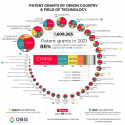You are using an out of date browser. It may not display this or other websites correctly.
You should upgrade or use an alternative browser.
You should upgrade or use an alternative browser.
News on China's scientific and technological development.
- Thread starter Quickie
- Start date
so China get another gem. this is become a normal routine. almost daily we heard news about 'top tier overseas talent join Chinese research center'..
Remember a year ago or two the internet were soyjacking over news that Chinese hypersonic engineers defected to UK or something?
*****************************************************************************************************************
After 20 years in UK, British chair professor joins China’s hypersonic programme
After more than 20 years in Britain as a prominent physicist dedicated to unveiling the secrets of superfast fluids, Zhang Yonghao has joined China’s new national hypersonic laboratory in Beijing.
The Chinese government hired Zhang as a top-tier expert from overseas to lead an innovation team at the national key laboratory of science and technology on aerothermodynamics in at the Chinese Academy of Sciences’ Institute of Mechanics.
According to the institute’s website, Zhang’s team will develop advanced computational methods and models for simulating gases’ behaviour at high speeds and temperatures crucial in making hypersonic vehicles more efficient and effective.
Their investigation into high-temperature aerodynamic and thermal effects on materials is crucial because hypersonic vehicles must withstand extreme temperatures and pressures during flight.
The institute said Zhang’s team was expected to “lead the world” in developing materials that surpass all existing standards in their ability to withstand different factors and pressure management.
Zhang’s contract was effective immediately after he resigned from the University of Edinburgh in October 2022, according to the institute.
The British government’s 2021 investigation into academics with ties to China raised concerns about national security and theft. These inquiries targeted individuals connected to Chinese organisations, including universities and research institutions.
In 2022, the investigations led to a record number of scientists and postgraduate students being barred from working in Britain for national security reasons.
The Guardian reported in March that the Foreign Office’s vetting programme rejected more than 1,000 people in 2022, up from just 13 individuals in 2016.
However, it is not clear why Zhang Yonghao – who had held the post of chair professor in multiscale fluid mechanics at the University of Edinburgh – decided to return to China to work in the Beijing-based national hypersonic laboratory. The South China Morning Post has contacted to Zhang’s office for comment.
Zhang has been working on developing new methods and models in the field of gas dynamics, specifically in the areas of rarefied gas dynamics and multiscale fluid mechanics.
The “new discrete velocity method” and “dense non-equilibrium gas dynamics model” are two examples of his contributions to the field.
The new discrete velocity method is a numerical technique that can simulate the flow of gases at different scales, from the macroscopic to the microscopic level.
This method is particularly useful for simulating rarefied gas flows, which occur at very low pressures and are difficult to model using traditional methods.
The dense non-equilibrium gas dynamics model is a theoretical framework that can describe the behaviour of gases under extreme conditions, such as high temperature and high pressure.
This model takes into account the non-equilibrium nature of dense gases, which means that they do not behave like ideal gases and require more complex models to accurately describe their behaviour.
These models help researchers better understand how gases behave at high speeds and in extreme conditions, which is important for the development of hypersonic aircraft.
Zhang graduated from an obscure college in southern China that trained students to repair agriculture machinery in the 1990s before working as a computational scientist at Daresbury Laboratory in Britain in the early 2000s.
He established himself as a leading expert in multiscale fluid mechanics. His research has focused on understanding multiscale and multiphysical flow physics through theoretical and computational studies, which is an area of growing importance in fields such as aerospace engineering, energy production and environmental science.
Zhang chaired the executive board of the International Symposium on Rarefied Gas Dynamics in 2018 as a chair professor at Strathclyde University.
By 2020, he was appointed chair professor at the University of Edinburgh.
In Britain, a chair professorship is typically the highest academic rank that can be achieved. It is a prestigious title awarded to individuals who have made significant contributions to their field of research and who are recognised as leaders in their discipline.
It remains unclear why Zhang terminated his professorship in Edinburgh in less than two years, but some Chinese scientists believe the growing anti-China sentiment in Britain might not be the only reason for his return to China.
“It is not uncommon for established scholars to move between institutions or countries to pursue new research opportunities or advance their careers,” said a Beijing-based physicist who also studied high-speed fluids but asked not to be named because of the sensitivity of the issue.
Britain does not have hypersonic weapons in its arsenal, but hypersonic flight research is a complex and multidisciplinary field that involves expertise in areas such as aerodynamics, materials science and propulsion systems.
It is possible Britain has strengths in some of these areas that are not reflected in its current military capabilities, according to the physicist.
China has developed numerous types of hypersonic weapons, and it plans to establish a fleet of hypersonic aircraft that can transport cargo or passengers to by 2035.
Zhang can benefit from working with Chinese researchers at the forefront of hypersonic flight research, which would provide him with access to cutting-edge facilities and resources, as well as opportunities to collaborate on high-impact research projects.
But Zhang’s background and experience in Britain could raise some concerns about his potential access to sensitive information related to China’s hypersonic weapon development.
“Given the highly secretive nature of this programme, it is likely that access to sensitive information would be tightly controlled and restricted only to those on a need-to-know basis,” said the Beijing-based physicist.
“Even if Zhang does not have direct access to sensitive information related to China’s hypersonic weapon development, he may still be able to contribute valuable expertise and insights based on his experience in multiscale fluid mechanics,” he added.
Zhang’s experience in organising large-scale projects and managing teams could be valuable for coordinating the efforts of researchers from different disciplines and institutions, because developing hypersonic flight technology will require collaboration between experts in many areas, according to his new employer, the Institute of Mechanics.
His international reputation as a leading expert in gas dynamics could also help attract top talent from around the world to work at the new laboratory, the institute said.
LOL
Remember a year ago or two the internet were soyjacking over news that Chinese hypersonic engineers defected to UK or something?
This is so instant karma
UK: Let's crackdown on our ethnic Chinese researchers. They might be collaborating with Huawei et al, which might aid China's military capabilities.
Ethnic Chinese researcher: Leaves and joins China's hypersonics program
LOL
This is so instant karma
UK: Let's crackdown on our ethnic Chinese researchers. They might be collaborating with Huawei et al, which might aid China's military capabilities.
Ethnic Chinese researcher: Leaves and joins China's hypersonics program
China will provide 100 illegal Chinese liberal dish washers in exchange so they won’t run out of slanty eyes to beat up.


China topped the chart in 29 out of 36 total fields including computer technology, electrical machinery, and digital communication. The Chinese government’s led to the nation’s applicants receiving 38% of the 1.6 million patents granted in 2021.
Wow, look at China's dominance in Civil Engineering, Special Machines, Machine Tools, Handling, Controls, Chemical Engineering, Materials Chemistry, Materials and Metallurgy.
Last edited:
some interesting points, people usually ignore.View attachment 112538
Wow, look at China's dominance in Civil Engineering, Special Machines, Machine Tools, Handling, Controls, Chemical Engineering, Materials Chemistry, Materials and Metallurgy.
1. Machine tools is the backbone of your high end manufacturing, without autonomous industry you can't do shit. Chinese machine tools makers went from outright rejection to world's number1 in patent grants. this industry was Germans and Japanese play ground but look how tables have turned. Chinese just won another crucial battle.
2. Materials/Metallurgy sector, another very very important field. civil aviation/aero engine/heavy duty gas turbine/hypersonic technology and plenty of other high end industries depend on materials. once Japan/USA were undisputed and look at now. LOL
3. Optics - surprisingly China is ahead of Germany and second only to Japan in patent grants. hugeee
4. Medical equipment - strongest zone of USA, but look how far China has come in this sector. surpassed Japan/Germany. came second to USA. recently we have seen progress of Chinese firms in high end medical machines/equipment like MRI/CT.
now the most important industry for me. Engine , Turbine and Pumps.
China came third after USA and Japan in 2021 but finished very close. my prediction is, China will surpass both USA/Japan in 2024-2025 in patent grants.
total number of patent grants from 2018-2021 in Engine , Turbine and Pumps as per WIPO -
1. Japan - 33,472
2. USA - 32,369
3. China - 25,424
4. Germany - 20,207
5. France - 10,091
total number of patent grants in 2021 in Engine , Turbine and Pumps as per WIPO -
1. USA - 7,334
2. Japan - 7,152
3. China - 6,598
4. Germany - 4,485
5. France - 2,398
historically, Engine components and gas turbine manufacturing dominated by three countries. Japan , Germany and USA. China leaves behind European powers in this sector indicate the rise of China in gas turbine industry. remarkable progress.

Last edited:
Chinese scientists develop cutting-edge tech for 3D ceramic printing in the air to create complex engineering parts
- Jiangnan University team creates new printing paste and improved curing technique to boost printing efficiency and remove need for support structures
- Ceramics are widely used in mechanical engineering, electronics and aerospace fields but their brittleness and hardness make manufacturing a challenge
Scientists in China have developed a new technique for of ceramics in the air without the need for supportive structures.
This cutting-edge method can construct ceramic parts at almost any angle, enabling the creation of shapes that were previously impossible for typical 3D printing techniques.
are widely used in mechanical engineering, electronics and aerospace fields because of their structural stability, wear-resistance and high-temperature endurance. But the inherent brittleness and hardness of ceramics have made manufacturing intricate parts a challenge.
3D printing, also called additive manufacturing (AM), has offered an efficient and convenient way to produce complex ceramics with integrated structures and functions.
In traditional 3D printing of ceramics, additional supporting structures are often needed to prevent the collapse of unsupported parts. This extra skeleton not only affects printing efficiency but also raises issues related to the removal of these supports.
Addressing these challenges, Professor Liu Ren and his team at Jiangnan University developed a new printing paste and an improved curing technique that helps the material solidify rapidly, enhancing 3D printing efficiency for ceramics and eliminating the need for support structures.
Their novel technique can instantly solidify multi-scale filaments with diameters ranging from 0.41mm (0.02 inch) to 3.5mm, successfully constructing various ceramic structures, such as torsion springs and cantilever structures.
The team’s findings were published in the peer-reviewed journal Nature Communications on April 25.
The new paste is a photosensitive ceramic slurry, which quickly solidifies and increases in strength on exposure to near-infrared (NIR) light. With certain NIR radiation intensity, the material holds its shape in mid-air immediately after being extruded from the nozzle.
“The printed curves can be freely extended in space without support. The printing process is smooth and continuous, without the need for heating or cooling,” Liu said in the paper.
The researchers also showed that NIR light can achieve a better effect than the commonly used ultraviolet (UV) light.
Cure depth – a measure often used to characterise the penetration ability of light – of the slurry was tested under NIR light and UV light separately.
The tests showed that under UV light, the curing depth can reach 1.02mm after 130 seconds. However, under NIR light exposure for 3 seconds, the curing depth reaches 3.81mm, meaning NIR enables faster high-precision printing.
In video demonstrations, Liu and his team printed three-dimensional curved structures horizontally at a speed of 1mm per second. The resulting ceramics maintained their shape well and remained stable even during subsequent processes of sintering, or compacting and shaping under high temperatures.
The technique was also used to create structures with sharp turns, such as torsion springs, although proper nozzle selection and laser positioning were essential to prevent their collapse or obstruction.
Multi-material 3D printing is also a challenging topic in ceramic construction, with different photocuring properties of ceramic materials potentially causing warping, delamination and cracks during high-temperature sintering.
The team showed the ability to print mixed ceramics by using additives such as iron red, chromium green or yttria-stabilised zirconia, which helped them to unify the sintering temperatures of ceramics with varying properties.
“The key to this technology is not only the elimination of the support required in a typical printing process, but also brings about many other advantages, such as reduced printing time, material usage and post-processing workload,” Liu said in the paper.
The refinement of ink components and printing parameters – such as nozzle diameter, extrusion pressure, movement speed and light intensity – could create objects with better resolution and distinctive aesthetics, the paper said.
Liu said this new technique of 3D printing had the potential to be taken further, and ceramic shapes made without support would inspire more innovation and make additive manufacturing technologies more widespread.
This is kind of obsolete. Those ARM cores and GPU cores are from like 5 years ago. Unisoc should be able to do better than this.Hisense F70 launched & will use Unisoc's T750 SoC, it's produced with 6nm process, so not by SMIC
At least it has integrated 5G modem I guess.
Even if they wanted to do a low end SoC they could have used the ARM Cortex-A510 core instead of the A55.
As is it has similar specs to the MediaTek Dimensity 810 which came out in Q3 2021.
Last edited:
